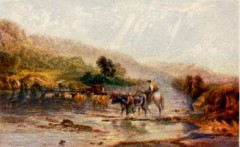Welsh Drovers and Welsh Corgis
 Imagine a huge, slow procession of hundreds of animals being herded along remote mountain tracks by men on sturdy ponies and on foot. It could be half a mile long from front to back, and would include small black cattle with wide horns, sheep, pigs, and even geese all walking in line.
Imagine a huge, slow procession of hundreds of animals being herded along remote mountain tracks by men on sturdy ponies and on foot. It could be half a mile long from front to back, and would include small black cattle with wide horns, sheep, pigs, and even geese all walking in line.
Small, short-legged Welsh corgi dogs would be snapping at the heels of the cattle to keep them moving at a steady pace, and men with sticks would walk alongside to keep them from straying from the track. This impressive sight was the passing of the drovers, a practice which had been carried out for hundreds of years but which was to end in the Victorian age with the coming of the steam railways. It then became much easier and quicker to load the livestock on to cattle trucks and send them to market by train. The reason for these long treks across country was to drive animals which had been bought relatively cheaply from farms and from local markets in north and West Wales to the much wealthier english buyers in Hereford, the Midlands and even Kent.
The reason for these long treks across country was to drive animals which had been bought relatively cheaply from farms and from local markets in north and West Wales to the much wealthier english buyers in Hereford, the Midlands and even Kent.
The trackways, which over the years became well worn by the hooves of thousands of animals, have since became known as drovers' roads- although hardly any were suitable for even horse-drawn carts at the time. One of the most important of these routes passed from west to east through Abergwesyn , just a few miles to the north of Llanwrtyd.
When the long procession of cattle, sheep, pigs, geese, ponies, men, and dogs were on their slow march over the hills the local farmers were given plenty of warning that they were coming. There would be the usual noise of herded animals, but the drovers would call and shout loudly when they approached farms or loose grazing livestock ! This was to warn the owners to get their animals safely out of the way, for if they got caught up in the mass of the drove it could be very hard to get them out again.

As the drovers could be on their routes for weeks they needed places to stop on the way for food and rest for men, shoeing, grazing and watering for animals.There were many inns at intervals along the regular route to meet the need of the droving trade providing room, food, ale and cider.The head drovers would sleep overnight in the inns but the younger helpers would stay outside to guard the livestock.
Many drovers were also farmers or inn-keepers as well as dealers in livestock and none could operate without a licence. Only men who were householders, were aged over 30, and were married, could apply for a droving licence. The drovers had charge of large numbers of valuable animals, and the livelihood of many farmers and other people in Wales depended upon their skill and honesty.

A slow moving procession of men and animals crossing remote areas in the hills was always in danger of being attacked and robbed if large sums of money were being carried. This led to the setting up of Welsh banks to provide money for buying the animals locally before the long journeys began and handling larcge amounts of cash from the sale of the livestock in England. Because of their trading contacts in London and elsewhere in England the drovers also were able to bring news and gossip back to Wales at a time when communications were very poor.
Drovers were well respected members of their community. A drovers wage was twice that of an ordinary labourer and not only was he entrusted with valuable livestock, but he would also have been relied upon to deliver letters, messages and other important documents. Drovers were also trusted with important financial commissions and were one of the country’s first bankers! Once the drove was over, some drovers may have stayed on to work the southern harvest. The landed drovers would have returned to their own harvests, selling their ponies at market and either walking back or taking the coach if the business had been good.
Perhaps, one of the most extraordinary stories of the trip home concerns the drover’s dogs. On completion of the drove, the collies and the corgis simply found their own way home! Incredibly they retraced the exact steps of the drove, stopping at the same inns to be fed by the inn keepers who had been paid on the way out by the drovers. Now that’s intelligence!




